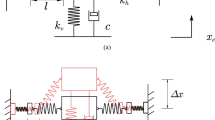Abstract
An anti-saturation fault-tolerant adaptive torsional vibration control method with fixed-time prescribed performance for the rolling mill main drive system (RMMDS) was investigated, which is affected by control input saturation, actuator faults, sensor measurement errors, and parameter perturbations. First, we gave a continuously differentiable saturation function to approximate the control input saturation characteristic of the RMMDS, translating the saturation characteristic into the matched uncertainty and unknown time-varying gain in the system. Then, an RMMDS mathematical model with unmatched uncertainty and unknown time-varying gain was developed, taking into account the presence of control input saturation, actuator faults, sensor measurement errors, and parameter perturbations. Based on the established mathematical model, an error transformation model of the roll speed tracking was constructed by the equivalent error transformation method. According to the error transformation model, a barrier Lyapunov function and a novel adaptive controller were studied to ensure that the roll speed tracking error always evolves inside a fixed-time asymmetric constraint. Finally, numerical simulations were performed in Matlab/Simulink to verify the effectiveness and superiority of the proposed control method in suppressing the RMMDS torsional vibration.






Similar content being viewed by others
References
J.X. Cui, Y. Peng, J. Wang, J. Iron Steel Res. Int. 30 (2023) 112–125.
X.Q. Yan, J.B. Qi, X.X. Wang, J. Iron Steel Res. Int. 26 (2019) 697–703.
Y.J. Liu, S. Wang, J.B. Qi, X.Q. Yan, J. Iron Steel Res. Int. 30 (2023) 1792–1802.
W.W. Lin, J.J. Wang, B.Y. Ren, J. Yu, X.L. Wang, T.H. Zhang, Construct. Build. Mater. 316 (2023) 125839.
M. Müller, K. Prinz, A. Steinboeck, F. Schausberger, A. Kugi, Contr. Eng. Pract. 103 (2020) 104584.
J. Sun, F. Hou, Y.J. Hu, L.J. Wang, H.Y. Jin, W. Peng, X.J. Li, D.H. Zhang, J. Iron Steel Res. Int. 30 (2023) 277–292.
R. Furlan, F.A. Cuzzola, T. Parisini, Contr. Eng. Pract. 16 (2008) 214–224.
N.Y. Lu, B. Jiang, X.F. Meng, H.P. Zhao, IEEE Trans. Syst. Man Cybern. Syst. 50 (2017) 137–148.
C.F. Zhang, K.X. Peng, J. Dong, Expert Sys. Appl. 167 (2021) 114166.
S. Yin, B. Xiao, S.X. Ding, D. Zhou, IEEE Trans. Ind. Electron. 63 (2016) 3311–3320.
Z.Q. Yu, Y.M. Zhang, B. Jiang, C.Y. Su, J. Fu, Y. Jin, T.Y. Chai, Mech. Sys. Signal Process. 153 (2021) 107406.
P. Shi, X. Wang, X. Meng, M. He, Y. Mao, Z. Wang, IEEE Trans. Power Electron. 38 (2023) 3676–3688.
Y. Wang, Z.S. Wang, IEEE Trans. Circuits Syst. II Exp. Briefs 69 (2021) 154–158.
Y. Wang, J. Xia, Z. Wang, H. Shen, Appl. Math. Comput. 369 (2020) 124841.
X.W. Bu, D.Z. Wei, G.J. He, Int. J. Robust Nonlinear Control 30 (2020) 2752–2776.
C. Qian, L. Zhang, C. Hua, Int. J. Contr. Autom. Syst. 19 (2020) 1264–1272.
C. Qian, C.C. Hua, L.L. Zhang, Z.H. Bai, J. Franklin Ins. 357 (2020) 12886–12903.
C.C. Hua, P.J. Ning, K. Li, IEEE Trans. Autom. Control 67 (2021) 6159–6166.
J. Tan, Y.F. Dong, P.Y. Shao, G.M. Qu, Aeros. Sci. Technol. 120 (2022) 107264.
L. Zhao, J.P. Yu, Q.G. Wang, IEEE Trans. Neural Netw. Learn. Syst. 32 (2020) 1474–1485.
Y. Zhao, Y. Zhou, P. Huang, G. Chen, IEEE Trans. Autom. Control 67 (2022) 4498–4513.
B. Xu, IEEE Trans. Syst. Man Cybern. Syst. 47 (2017) 161–170.
W. Wang, B. Xie, Z.Y. Zuo, H.J. Fan, IEEE Trans. Ind. Electron. 66 (2018) 3752–3762.
J. Na, Y.B. Huang, Q.Q. Pei, X. Wu, G.B. Gao, G. Li, IEEE/ASME Trans. Mechatronics 25 (2019) 779–791.
L.N. Bikas, G.A. Rovithakis, IEEE Trans. Autom. Control 68 (2023) 96–107.
Acknowledgements
This work is supported by Central Government to Guide local scientific and Technological Development of Hebei Province (No. 216Z1902G), Major Program of National Natural Science Foundation of China (U20A20332), Natural Science Foundation of Hebei Province (A2022203024), and Provincial Key Laboratory Performance Subsidy Project (22567612H).
Author information
Authors and Affiliations
Corresponding author
Ethics declarations
Conflict of interest
The authors declare that they have no financial interests which could influence this paper.
Rights and permissions
Springer Nature or its licensor (e.g. a society or other partner) holds exclusive rights to this article under a publishing agreement with the author(s) or other rightsholder(s); author self-archiving of the accepted manuscript version of this article is solely governed by the terms of such publishing agreement and applicable law.
About this article
Cite this article
Liu, S., Du, C., Zhang, C. et al. Anti-saturation fault-tolerant adaptive torsional vibration control with fixed-time prescribed performance for rolling mill main drive system. J. Iron Steel Res. Int. 31, 660–669 (2024). https://doi.org/10.1007/s42243-023-01095-0
Received:
Revised:
Accepted:
Published:
Issue Date:
DOI: https://doi.org/10.1007/s42243-023-01095-0




